
Posted on 06/30/2011 5:46:58 AM PDT by Homer_J_Simpson


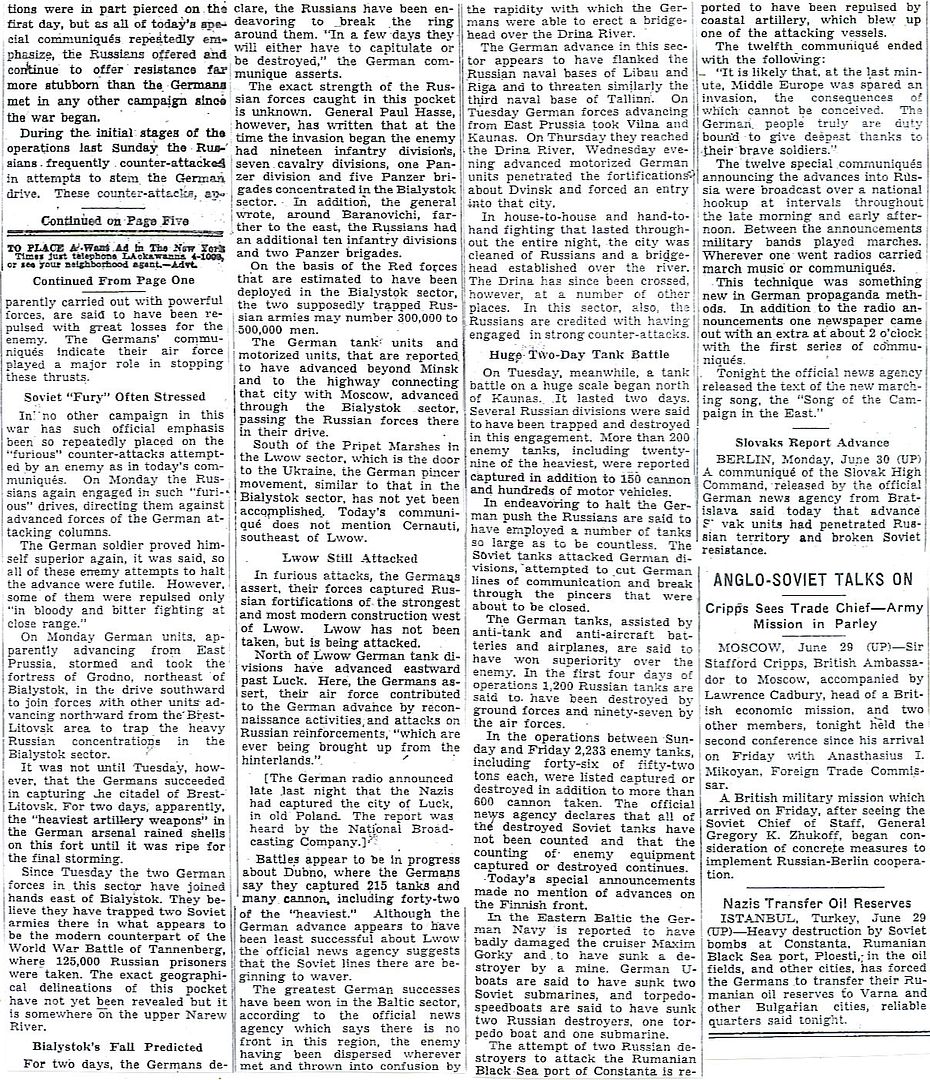

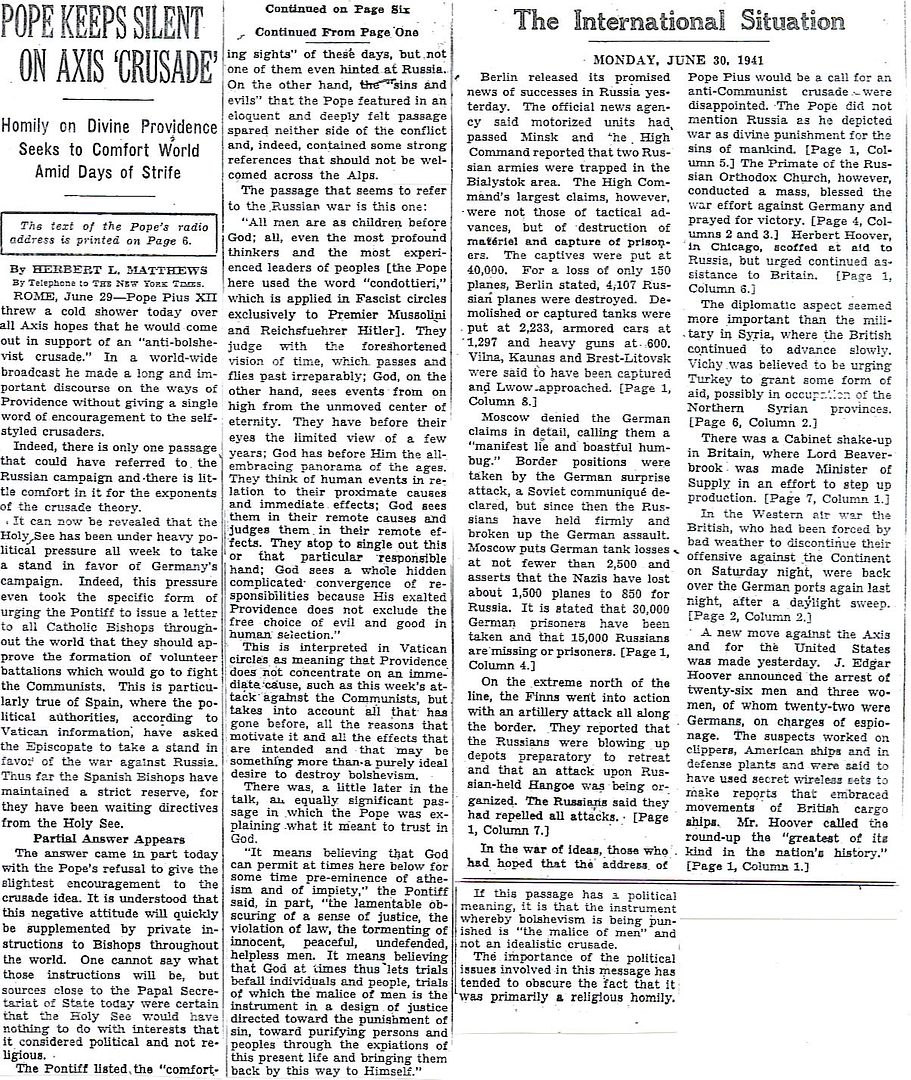
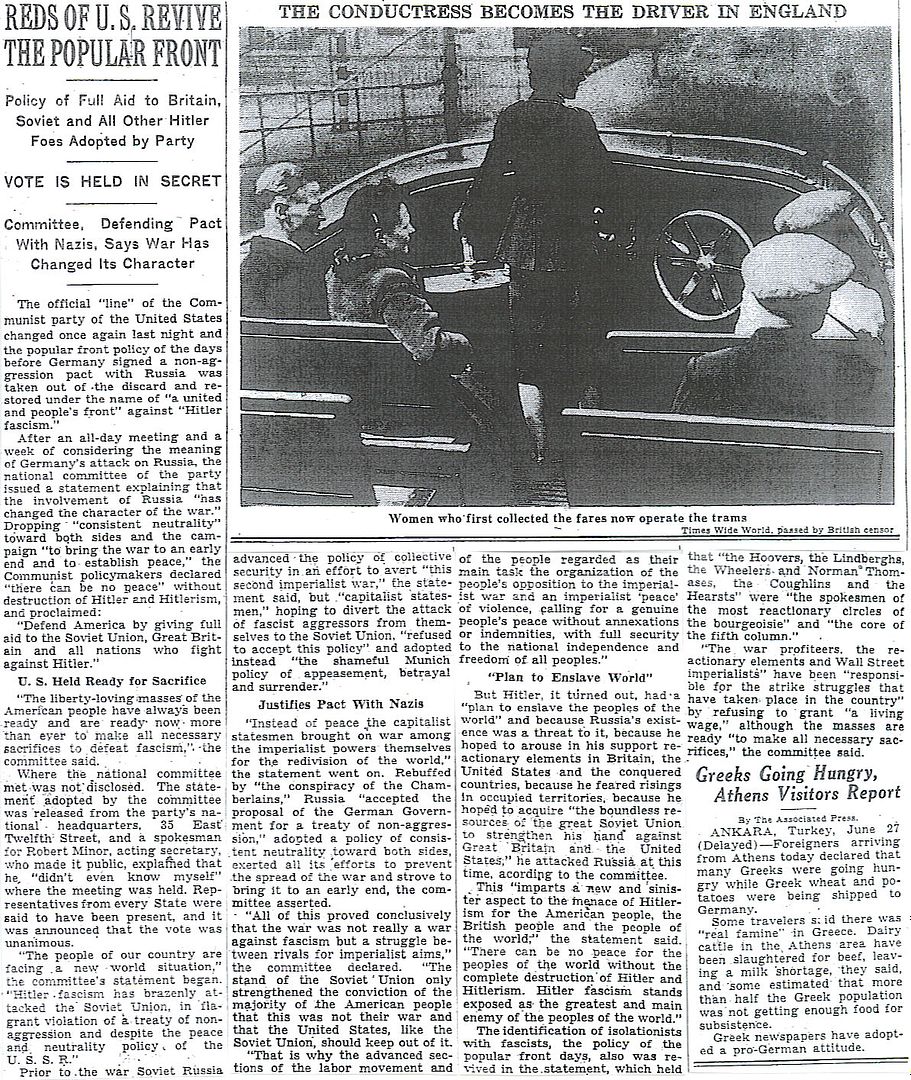
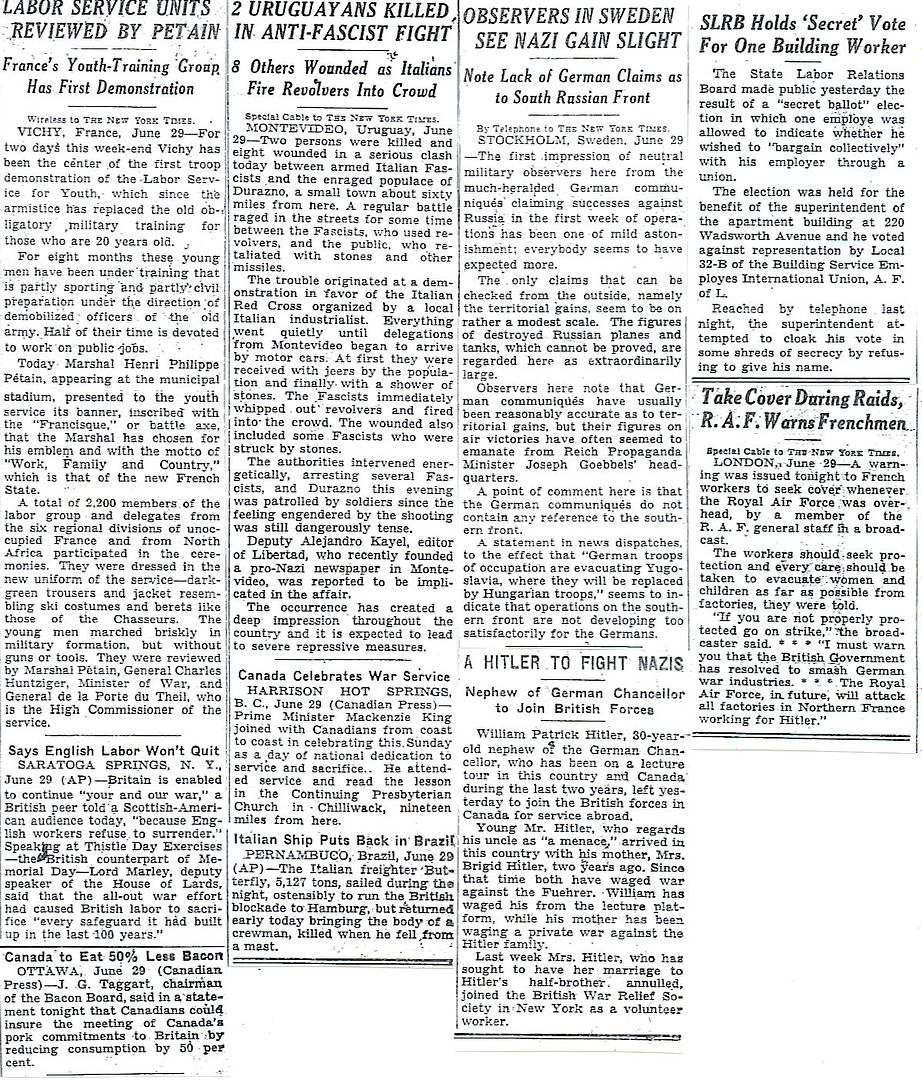
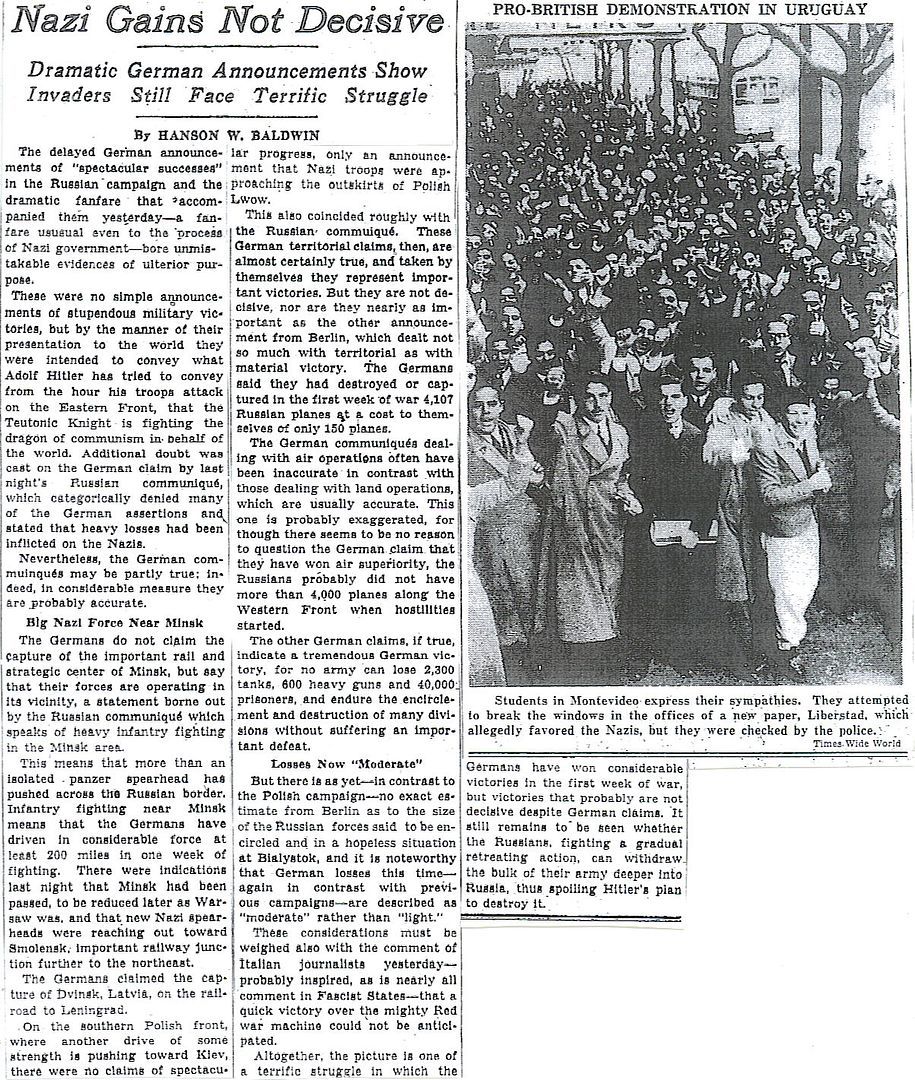
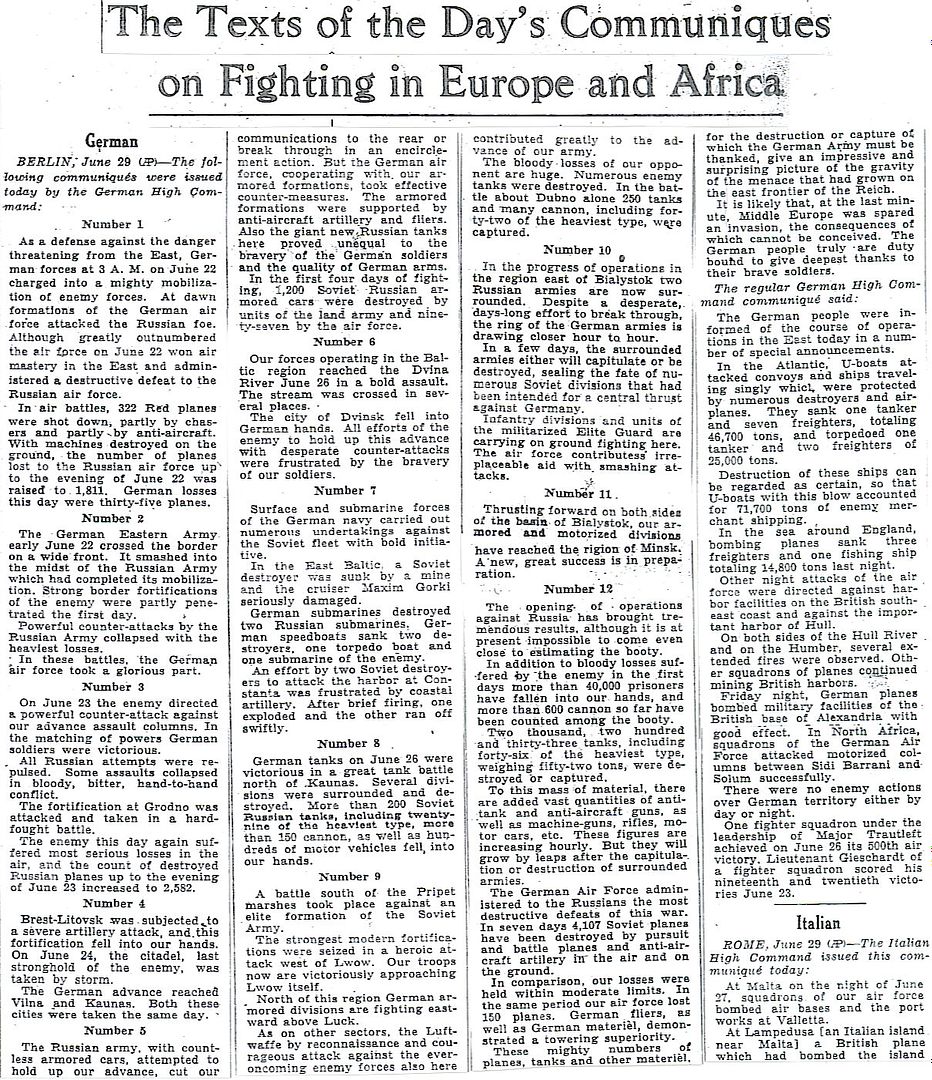
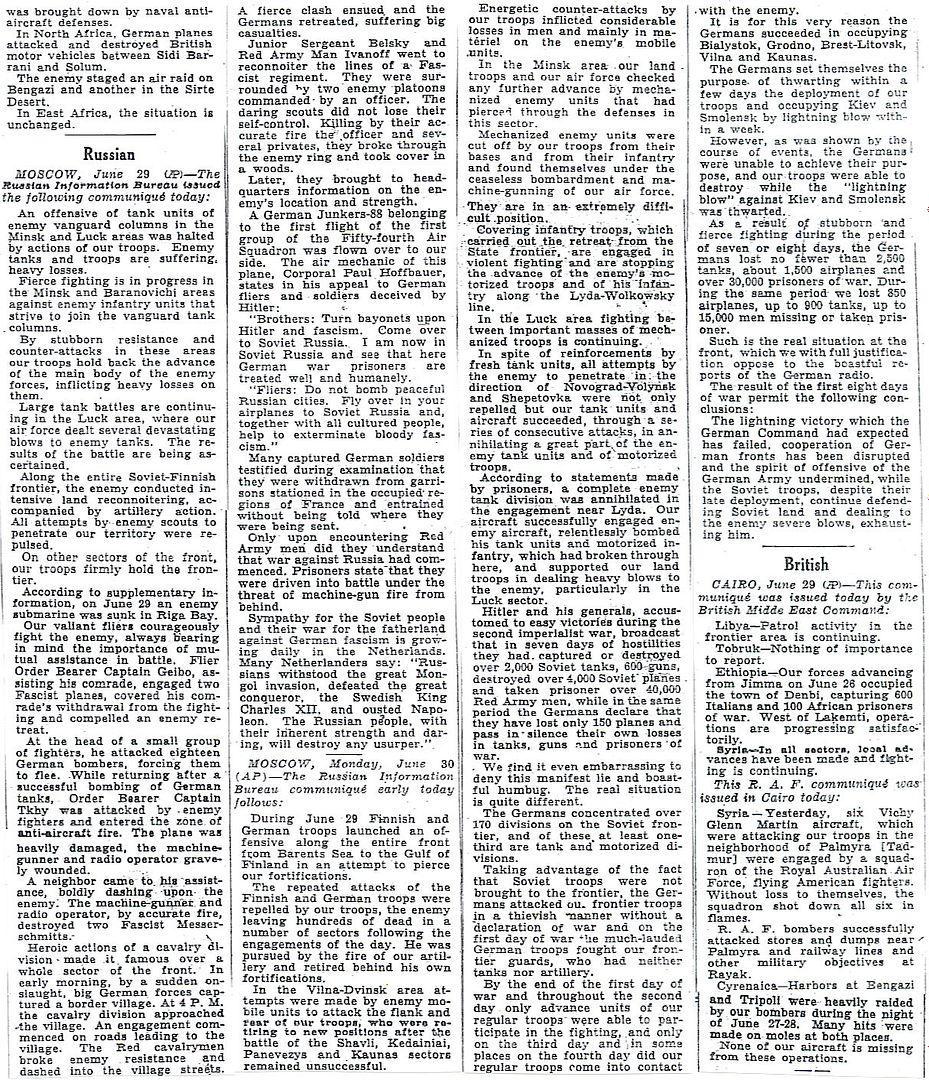
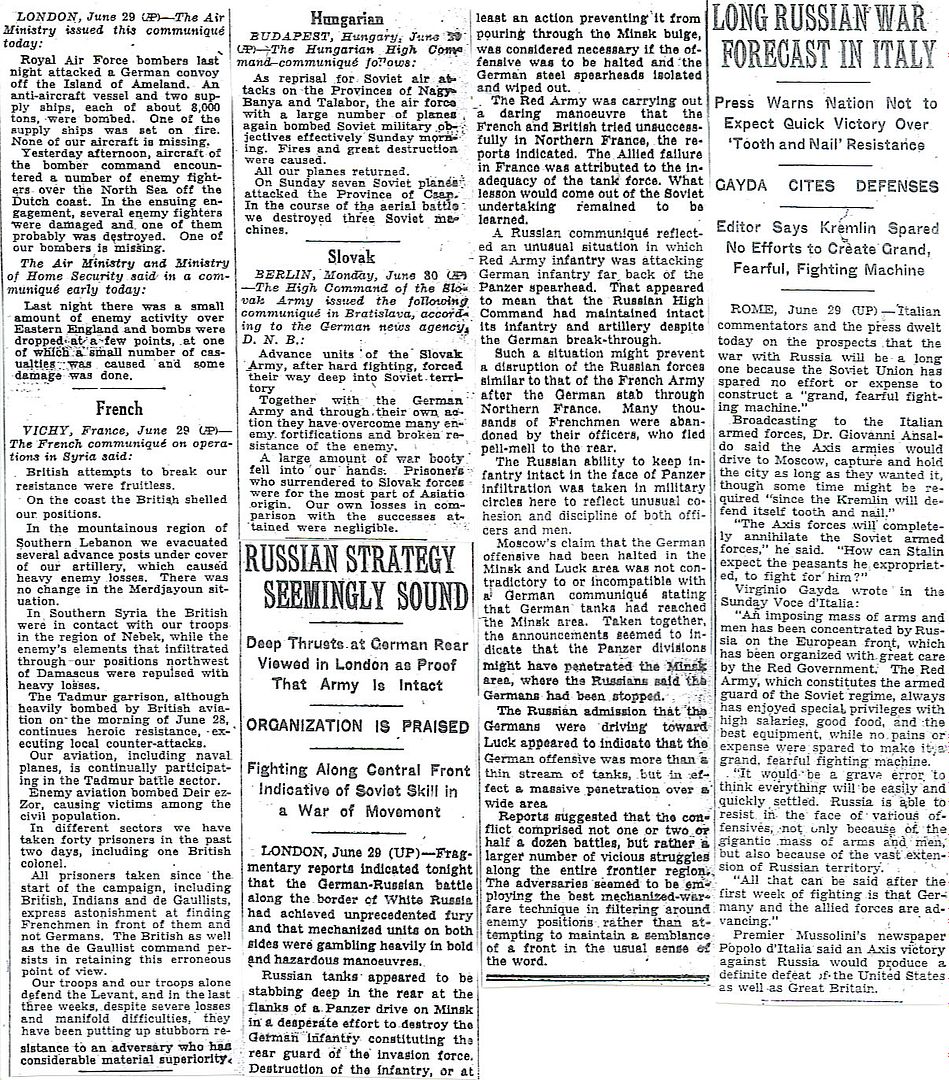

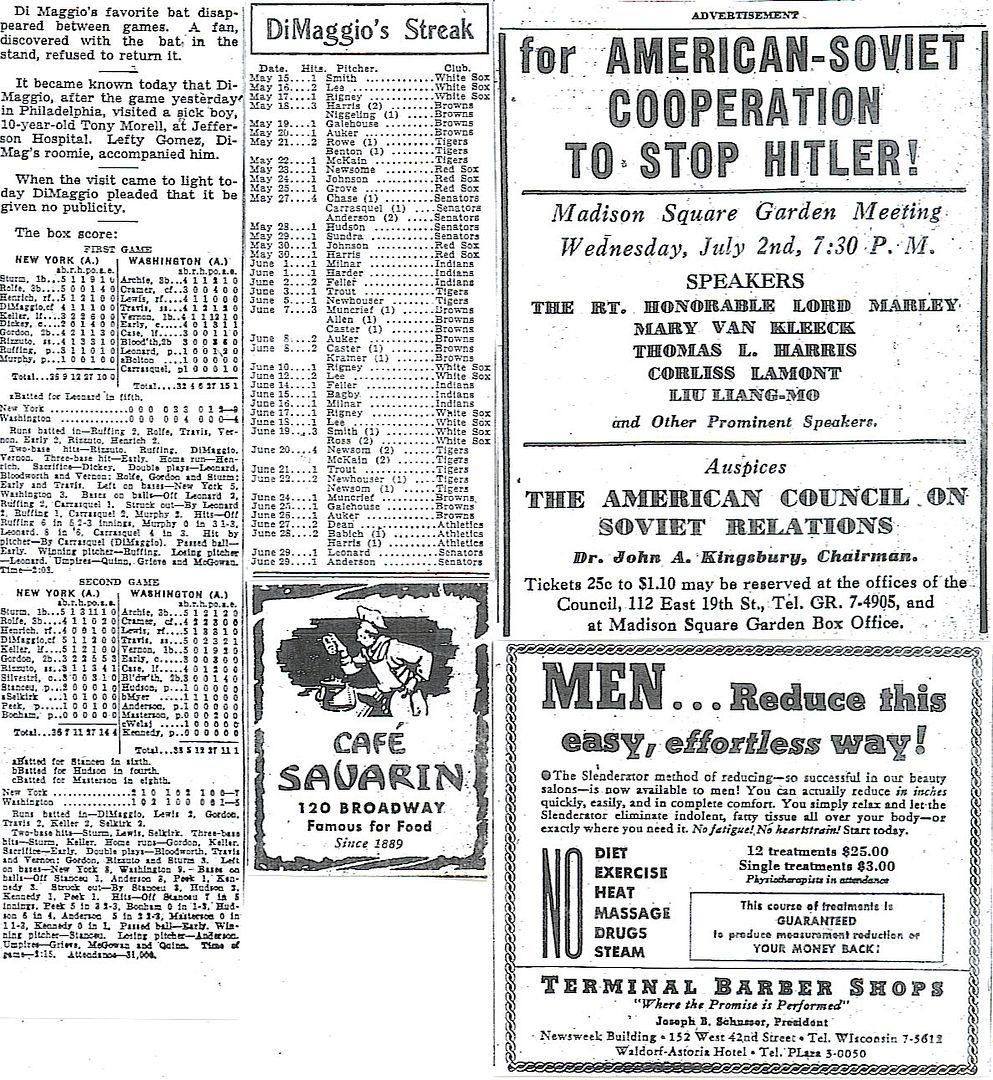
Yankees Conquer Senators, 9-4, 7-5 – 12-13
DiMaggio’s Streak – 13
http://www.onwar.com/chrono/1941/jun41/f30jun41.htm
German advance reaches Berezina
Monday, June 30, 1941 www.onwar.com
On the Eastern Front... Bobruisk is taken by Panzer Group 2 (part of Army Group Center) and operations begin to cross the Berezina River. Troops from Army Group South take Lvov while to their left other units make deeper advances toward Kiev.
In Moscow... The formation of a new State Committee of Defense is announced. The members will be Stalin, Molotov, Voroshilov, Malenkov and Beria. Stalin is very much in charge.
There’s a nice coincidence. We have a rare excerpt from the Stilwell book and then Joe’s pal Mrs. Peanut is the cover girl.
We've got to strike at the root of these continuous Russian break-out attempts. We've got to ferret them out of their woods Lieutenant-Colonel Franz, the Chief of Operations of 29th Motorized Infantry Division, suggested to his commander, Major-General von Boltenstern. The divisional commander agreed.
"Colonel Thomas to the commander!" The CO of the Thuringian 71st Infantry Regiment reported at headquarters. Maps were studied. A plan was worked out. And presently Thomas's combat group moved off into the wooded ground on the Zelvyanka sector, with parts of 10th Panzer Division, Panzerjägers (Panzer killers), two battalions of 71st Infantry Regiment, two artillery detachments, and sappers. They moved in two wedge-shaped formations. The divisional commander went along with them. Only then did they discover the kind of forces they had to deal with—considerable parts of the Soviet Fourth Army which, having rallied at Zelvyanka, were now trying to fight their way out of the pocket to the east. They intended to break through towards the Berezina. There they hoped they would be able to hold a new defensive position, the Yeremenko Line, which they had been told about in radio messages.
Numerically the German formations were greatly inferior. The Russians fought fanatically and were led by resolute officers and commissars who had not been affected by the panic which followed the first defeats. They broke through, cut off Thomas's combat group, moved their tanks against the rear of the 1st Battalion, 15th Infantry Regiment, and tried to recapture the railway-bridge to Zelva.
The divisional staff officers were lying in the infantry foxholes with carbines and machine pistols. Lieutenant-Colonel Franz commanded a hurriedly established road-block of antitank guns. The Russians were stopped. And at long last the German infantry divisions arrived. The 29th Motorized Infantry Division was able to move off to the north, towards new operations of decisive importance. A fortnight later the division's name would be on everybody's lips.
The Berezina, literally the "Birch River," a right-bank tributary of the Dnieper, enjoys a fame of its own in Russian history. It was here that in November 1812 Napoleon, retreating from Moscow, suffered those crushing losses which meant the final end of his Grande Armée. There is no doubt that Yeremenko too had this historic precedent in mind when, in the evening of 29th June 1941, upon assuming command of the Soviet Western Front in the Minsk area, he issued his first order. It ran:
"The Berezina crossings are to be held at all costs. The Germans must be halted at the river."
When Yeremenko issued this order he was not yet aware of the full extent of the Soviet disaster on the Central Front. He supposed fighting divisions where none were left. He relied upon defenses which had long been abandoned. He wanted to hold the Germans on the Berezina at a time when the marching orders of Guderian's Panzer divisions already mentioned the Dnieper. He placed his hopes in units which were already shuffling into captivity, such as General Potaturchev's 4th Armoured Division.
How Yeremenko's hopes came to naught was recounted to the author by General Nehring, commanding the German 18th Panzer Division. "In the evening of 29th June," Nehring recalled, "the spearheads of 18th Panzer Division had reached Minsk. Parts of Hoth's Panzer Group—the 20th Panzer Division—had taken the city on 28th June. The 18th Panzer Division was ordered to drive past Minsk in the south, along the motor highway, towards Borisov on the Berezina, and to form a bridgehead there. At the time the whole enterprise seemed like suicide, but it was nothing of the sort. However, that could hardly have been foreseen. The division, relying entirely upon itself, thrust some sixty miles into enemy-held territory."
Nehring moved off early on 30th June. Ahead lay excellent new roads. The tank commanders were delighted. But presently the division met Russian resistance from strongly fortified positions. The Russians fought desperately. It was clear that Yeremenko's orders had been : Hold out or die. He needed time to establish a new line of defences. Could the race against time be won? Nehring was determined to outrace Yeremenko. While the bulk of his division was engaged against the Russians he formed an advanced detachment under Major Teege —the 2nd Battalion, 18th Panzer Regiment, and with them, riding on the tanks, men of the regiment's motor-cycle battalion and parts of a reconnaissance detachment, as well as Major Teichert's artillery battalion.
By noon on 1st July Teege had reached Borisov. The Russians were taken by surprise but resisted furiously. They were officer-cadets and NCOs of the armoured forces training college in Borisov. They were crack troops. They realized the importance of the bridge over the Berezina. They defended it fanatically, but, strangely enough, did not blow it up. The German advanced detachment suffered heavy losses. Yeremenko threw into the battle whatever he could lay hands on in the Borisov area. But then the bulk of the German division came up. In the early afternoon two battalions of 52nd Rifle Regiment, supported by tanks, launched an assault on the Russian bridgehead on the western bank. 10th Company of this regiment worked its way through the Soviet defenses. Sergeant Bukatschek led No. 1 Platoon. He reached the bridge. He fought down the two machine-gun posts on the ramp. He got a rifle bullet in his shoulder, but regardless he raced across the bridge with his men and captured the demolition squad on the other bank before the Soviet lieutenant could push down the plunger.
Teege's tanks and the motor-cycle troops, together with Laube's anti-aircraft battery, crossed the Berezina. The 8-8-cm. guns of the second battery secured the bridge against Soviet attacks. On the following morning, at first light, when Soviet crack battalions drove down the road on lorries from Borisov in order to eliminate the bridgehead, Second Lieutenant Doll with his 8-8-cm. battery blasted the column off the highroad and, at the cost of heavy losses, held the vital bridge against snipers, assault detachments, and tanks. The river, fateful since Napoleon's campaign in Russia, had been conquered. The road to the Dnieper was clear. Fifty miles farther south General Model's 3rd Panzer Division had already crossed the river at Bobruysk, and farther south still 4th Panzer Division, of General Freiherr Geyr von Schweppenburg's corps, was likewise across and driving towards Mogilev. Yeremenko had lost the round on the Berezina. The date was 2nd July 1941, the day when Alexander Rado in Geneva sent the radio signal to the Kremlin: " The object of the German operation is Moscow."
On the following day Marshal Timoshenko personally assumed supreme command of the Russian Western Front. Yeremenko became his second-in-command.

German radio unit north of Minsk 6-29-41
German Infantry unit prepares to resume march early in the morning-west of Minsk
 Soviet pows prepare to march west Nowogrodek 6-30-41
Soviet pows prepare to march west Nowogrodek 6-30-41
Showing off a captured Soviet flag outside a Soviet regimental headquarters 7-1-41
Members of a Wehrmacht anti-tank unit take cover from unknown Soviet sniper-July 1941
Soviet Statue toppled in Lvov-July 1941
German troops who are clearly unhappy being photographed as they move a wounded comrade. This is late July and causalities from Soviet snipers were starting to take a toll on the frustrated Germans. Photo was probably taken by one of Goebbel's propaganda companies which accompanied certain units.
In the past I had the vague idea that Barbarossa was a sort of pell-mell romp for the Germans in the early months and only became a painful ordeal when the weather began to change. I have seen the error of my ways.
Lol..."Joe's pal"....aka...Madame "Cash-My-Check"...Thanks Homey.
http://homepage.ntlworld.com/andrew.etherington/month/thismonth/30.htm
June 30th, 1941
UNITED KINGDOM: The Maud Committee, set up last year to study the feasibility of producing a bomb based on nuclear fission, has presented its findings to the government. It concludes that such a bomb containing 25 pounds of active material would produce an effect equivalent to 1,800 tons of TNT, as well as large quantities of radioactive substances. The material for the first bomb could be ready by 1944, although the plant to produce it will cost 1.25 million pounds.
London:
Churchill to Minister of Supply:
In the recent session on Sir Andrew Duncan’s vote, questions were asked by Mr. Shinwell and others about how we stood in “heavy tanks.” We have hitherto regarded A.ss as the heaviest we should make, though a great deal of work has been done, I think by Stern, on a still larger type. I believe that there is even a pilot model. Of course our problem is different from the Russian or great Continental Powers because of shipment, although that is no final bar.
However, it now appears, on the highest authority, that the Russians have produced a very large tank, said to be over 70 tons, against which the German A/T 6-pounder [Panzer IV] has proved useless. It seems to me that the question of a much heavier tank has now come sharply to the front. The whole position must be reviewed, and we must know where we are - and that soon.
AA cruiser HMS Euryalus commissioned. (Dave Shirlaw)
FRANCE: Vichy severs diplomatic relations with the Soviet Union.
U.S.S.R.: The German Second Panzer Group captures Bobryusk, Russia. Army Group South captures Luvov. In the north the Germans advance toward Kiev.
The Luftwaffe scored a shattering victory over the Red Air Force in the first minutes of Operation Barbarossa. Aircrews flying He-111, Ju88 and Do17 bombers in flights of 3 at great height to avoid detection swooped on 66 Russian airfields. The Russians did not stand a chance. Their aircraft, parked wingtip to wingtip, were blasted by small fragmentation bombs, and then the bomber wheeled over the airfields to machine gun the burning wreckage. Hardly a shot was fired back. Then followed Stukas and Me110 fighter-bombers systematically working their way round the airfields which together with HQs, barracks and artillery positions, had been pinpointed by high-flying reconnaissance aircraft in the weeks before the invasion. After a day’s fighting the Soviets have lost 1,811 aircraft - 1,489 on the ground and 322 in the air - for the loss of only 35 German machines.
The fast moving German columns have pierced the Soviet defences wherever they attacked, leaving behind thousands of Russian soldiers to be dealt with by the infantry. General “Fast Heinz” Guderian is covering 25 miles a day with his panzer group, crossing rivers with tanks fitted with Schnorkel air tubes and extended exhausts. The German’s estimate that they have taken 150,000 prisoners and destroyed 1,200 tanks and 600 guns.
The German plan is based on three army groups:
1. Field Marshal Wilhelm von Leeb, commanding Army Group North, is driving through the Baltic states towards Leningrad, which is also being threatened by the Finns.
2. Field Marshal Fedor von Bock’s Army Group Centre has the strongest tank forces and has been ordered to encircle and destroy the Soviet forces in Byelorussia, thus opening the road to Moscow.
3. Army Group South, under Field Marshal Gerd von Runstedt, is preparing for a holding attack from Romaniainto Bessarabia, while a tank force thrusts deep into the Ukraine towards Kiev to cut off the defenders.
The Soviets are launching counter attacks against all three groups, but they have not succeeded in holding the Germans yet.
The western front commander, General Dmitri Pavlov, and his leading officers are executed for incompetence on Stalin’s orders.
Hitler’s hangmen are pouring into the USSR behind his tanks. As the Germans advance they festoon the landscape with multiple gallows, each with its full quota of Soviet officials and political commissars. The policy of terror is being carried out by front-line troops as well as by the special task forces of the Gestapo. Hitler has ordered that every officer has the right to shoot any person suspected of “criminal action”.
Russians, like all Slavs, are regarded as Untermenschen, sub-humans, by the Germans and killed with casual brutality. No preparations have been made to deal with the thousands of prisoners that the Germans are taking, and they are being left to rot without food or medical attention. There is no doubt that the Nazis intend to follow the extermination policy which they inflicted on the Poles and wipe out all Russians capable of mounting any form of resistance. Rule by terror.
Himmler has been designated to act independently of the army to carry out “special tasks”. His SS “Einsatzgruppen”, have moved into the war zone and begun to massacre the Jews.
Luftwaffe: JG 51 claims its 1,000th victim of the campaign.
Moscow:
The Soviet Information Bureau announced:
Fighting is continuing against strong enemy motorised forces in the Lutsk area. Despite his fresh armoured reinforcements, all the enemy’s attempt to break through our lines in the direction of Novograd Volynskiy [Ukraine] and Shepetovka have failed and been beaten back. Our armoured forces and the Soviet air force even succeeded in destroying a great part of the enemy armoured and motorised troops.
FINLAND: The first larger scale Finnish action in the Continuation War. Col. Blick’s 2nd Division (II Corps) at central Karelia is given the task to capture the straits between lakes Pyhäjärvi and Tyrjänjärvi to get good starting positions for the coming large scale attack. After meeting surprisingly heavy opposition, the division finishes its task by 7 July. (Mikko Härmeinen)
The German 163.Infanterie-Division, also known at the time as the ‘Engelbrecht Division’ (after CO Gen.d.Artillerie Erwin Engelbrecht), was allowed to cross neutral Sweden from Norway to Finland to became part of Mannerheim’s Finnish Karjalan Armeija (Army of Karelia) (in reserve) by 30 June, 1941. I’ve read that this particular group of German soldiers passed through Sweden without arms or armament of any sort, carrying only personal belongings in normal passenger cars with the curtains drawn on the compartments to remain anonymous.
[This same division had played a major role during Operation ‘Weseruebung’ (the invasion of Norway in 1940), and would fight for the most part in the northern salient of the Russian front, shattered by Spring 1945, and disbanded to be used as cadre for the ad-hoc Kriegsmarine 3.Marine Infanterie Division.]
As far as I know, this was a one time Swedish allowance of such a large (divisional) contingent of German troops to cross from Norway to the Eastern front. Subsequent crossings were allowed of ‘neutral’ Swedish territory, but would thereafter be made by German soldiers travelling singly or in small groups as replacements to units in the East. It is estimated that nearly 250,000 Germans passed from west to east in this manner. (Russ Folsom)
SYRIA: After weeks of vigorous patrolling and incremental advances, 21 Aust Bde (Brig Stevens) has secured the whole of the ridge overlooking the Damour River, the main obstacle between 7 Aust Div and Beirut. Patrols begin to recce the approaches to the river and northern bank. At Nebek (north of Damascus), elements of French I/16 Tunisian Bn (supported by 14 R35 tanks and artillery) attack 2 Free French Bn (supported by British arty and A/T guns). The French are initially successful then driven off by Free French counter-attack. (Michael Alexander)
The Headquarters of General Wilson (Allied commander in Syria) announced:
The Allied offensive against Homs (Syria) is making substantial progress. An Australian squadron flying American-model aircraft, shot down a formation of 6 Vichy-French Glenn Martin bombers in aerial combat. The Australians came back without losses to themselves.
MEDITERRANEAN SEA: Insect class river gunboat HMS Cricket escorting a convoy from Mersa Matruh to Tobruk is damaged by a near miss bomb. She is taken in tow but found unfit for further sea duty. She is then employed as a floating AA platform until she is scuttled off the south coast of Cyprus where she lay undisturbed until her hull was discovered by RE divers during the 1980’s. (Alex Gordon)(108)
AUSTRALIA: Minesweeper HMAS Launceston launched. (Dave Shirlaw)
U.S.A.: Turboprop engine development was initiated as a joint Army-Navy project, with a Navy contract to Northrop Aircraft for the design of an aircraft gas turbine developing 2,500 hp (1,864 kW) at a weight of less than 3,215 pounds (1,458 kg). (Jack McKillop)
The Dutch government in exile signs a contract with North American Aviation for 162 Model 90 (B-25-C-5-NA) Mitchells. The Dutch pay cash for them. Terms of the contract specified the delivery of 25 aircraft in November 1942; 50 in December; 80 in January 1943 and the last 7 in February 1943.
The USN places an order for two Grumman XF6F-1 Hellcat prototypes, BuNos 02981 and 02982. (Jack McKillop)
On this date, the USN has 1,899 ships and district craft and 338,786 personnel consisting of 284,427 sailors and 54,359 Marines. There are also 19,235 members of the USCG. (Jack McKillop)
By this date the US Army has accepted 85 SCR-268 radar sets into service for AAA defence. (Will O’Neil) (157,158,159,160,161 and 162)
Heavy cruiser USS Boston laid down.
Destroyers USS Hobby and Kalk laid down.
Submarine USS Grayback commissioned. (Dave Shirlaw)
CANADA: Minesweeper HMCS Trois Rivieres (ex HMCS Three Rivers) launched Sorel, Province of Quebec.
Corvette HMCS Camrose commissioned.
Minesweeper HMCS Wasaga commissioned. (Dave Shirlaw)
BATTLE OF THE ATLANTIC:
Shipping losses in the MEDITERRANEAN SEA:
3 ships of 9,000 tons.
Shippping of losses in home waters:
34 ships of 86,000 tons.
Losses in the ATLANTIC OCEAN:
70 ships of 329.000 tons.
4 German and 1 Italian U-boat.
Disclaimer: Opinions posted on Free Republic are those of the individual posters and do not necessarily represent the opinion of Free Republic or its management. All materials posted herein are protected by copyright law and the exemption for fair use of copyrighted works.